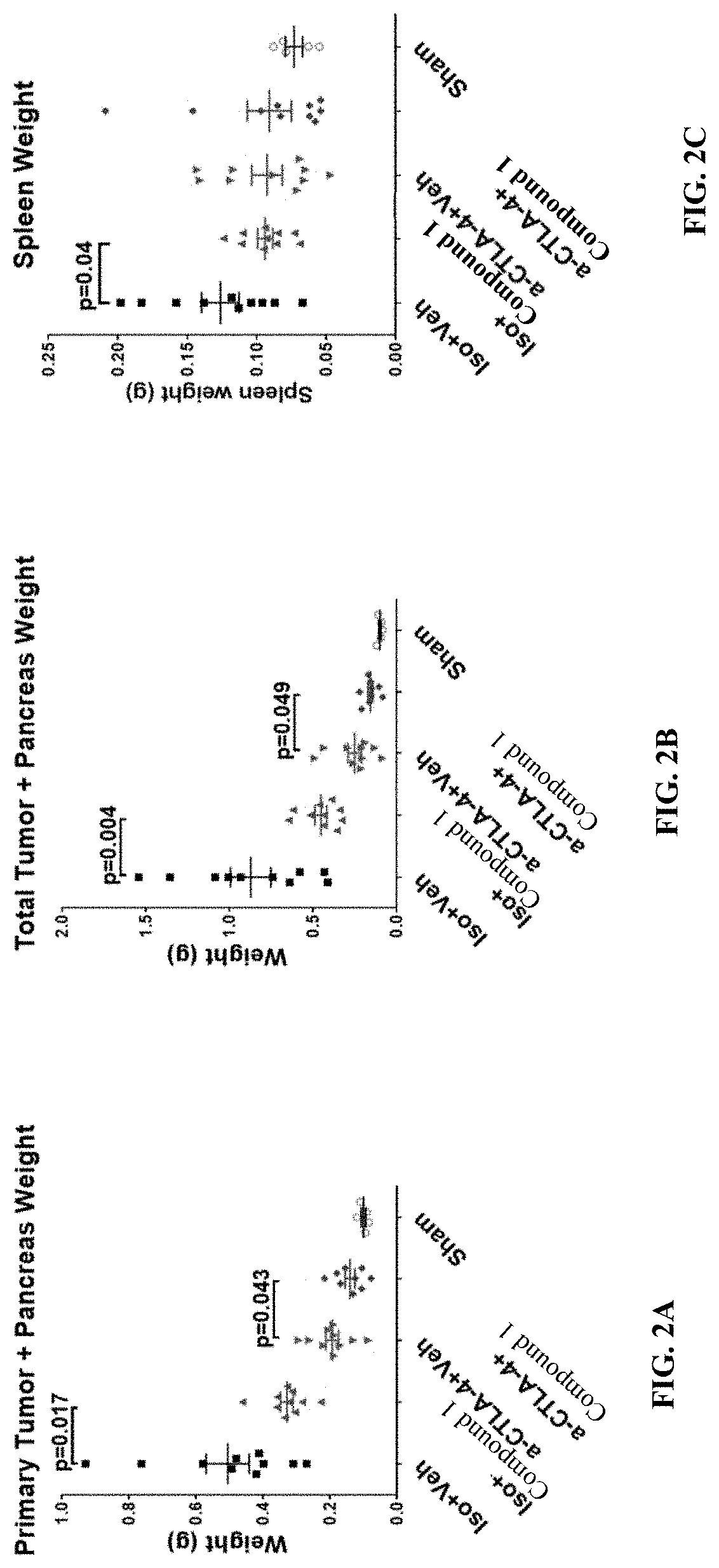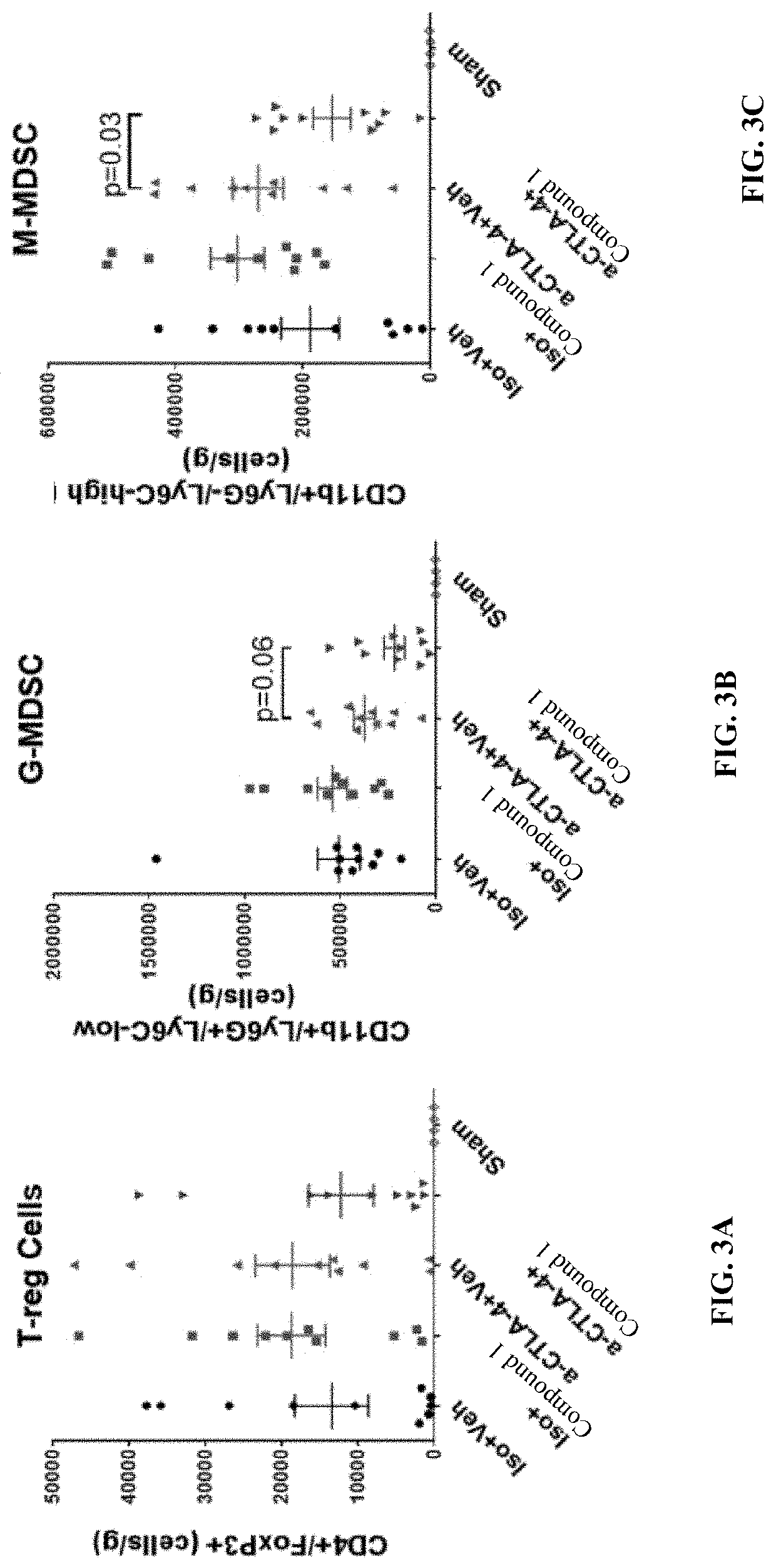Combination therapy using C-C chemokine receptor 4 (CCR4) antagonists and one or more immune checkpoint inhibitors
a technology of inhibitor, which is applied in the field of conjugation therapy of a c-c chemokine receptor 4 (ccr4) antagonist and one or more checkpoint inhibitors, can solve the problem that disease remains a leading cause of death
- Summary
- Abstract
- Description
- Claims
- Application Information
AI Technical Summary
Benefits of technology
Problems solved by technology
Method used
Image
Examples
example 1
kine Receptor 4 (CCR4) Antagonism Enhances the Effectiveness of Checkpoint Inhibition in Mouse Tumor Models (Summary)
[0182]Chemokines and their receptors influence many of the hallmark processes in cancer: they act not only on infiltrating leukocytes, but also on fibroblasts, endothelial cells and directly on some types of tumor cells. C—C Chemokine receptor 4 (CCR4) and its ligands have been found to be highly expressed in multiple types of human tumors, and are associated with poor prognosis. CCR4 antagonism has been demonstrated to reduce tumor growth in various mouse tumor models. Here we assess small molecule inhibition of CCR4 as a therapeutic agent to potentiate the effects of checkpoint inhibitors in the CT26 and KCM tumor models.
Methods
[0183]The subcutaneous CT26 colon cancer model and the orthotopic KCM pancreatic cancer model were used to assess the effects of a CCR4 inhibitor, Compound 1, in combination with anti-CTLA-4 antibody (BioXcell: anti-mouse CTLA-4 (Clone: 9H10)...
example 2
1 is a Highly Potent and Selective CCR4 Inhibitor
[0186]The selectivity of Compound 1 was tested by determining the IC50 value against a diverse panel of receptors, enzymes, and ion channels. Compound 1 was found to be highly specific for CCR4. See, Table 1.
[0187]
TABLE 1Compound 1 SelectivityReceptorBuffer IC50 (nM)CCR1>10,000CCR2>10,000CCR42CCR5>10,000CCR6>10,000CCR7>10,000CCR8>10,000CCR9>10,000CCR10>10,000CCR12>10,000CXCR1>10,000CXCR2>10,000CXCR3>10,000CXCR4>10,000CXCR6>10,000CXCR7>10,000Duffy>10,000
[0188]The binding activity of Compound 1 in humans and mice is reported in Table 2.
[0189]
TABLE 2Cross Species ActivityBinding IC50Chemotaxis A2(nM)(nM)BufferBuffer100% serumSpeciesCells125I-CCL17CCL22CCL22HumanCEM23220Lymphocytes371020MousemCCR4-Baf3460mCCR4-29327
example 3
on Therapy Using a KCM Orthotopic Pancreatic Tumor Model
[0190]As briefly described in Example 1, above, a KCM pancreatic cancer model was used to assess the effectiveness of a CCR4 inhibitor in combination with an anti-CTLA-4 antibody. The study design is shown in FIG. 1. The mice were broken into 4 groups (n=12 each group): isotype antibody+Vehicle; Isotype Antibody+Compound 1; anti-CTLA-4+Vehicle; anti-CTLA-4+Compound 1. The mice used were 7-8 week old C57BL / 6 female mice. Anti-CTLA-4 (BioXcell: anti-mouse CTLA-4 (Clone: 9H10), raised in Syrian Hamster, purified with protein G) and isotype matched control antibody were injected i.p. at 100 μg / mice on day 7, 11, and 16. Compound 1 (40 mg / kg) and vehicle dose p.i. twice daily (bid). KCM cells in matrigel were injected into the pancreas.
[0191]After completion of the study, the tumor / pancreases weight for each group was measured. The results are shown in FIG. A-C. As displayed in this figure, Compound 1 alone or in combination with an...
PUM
| Property | Measurement | Unit |
|---|---|---|
| tumor weight | aaaaa | aaaaa |
| volume | aaaaa | aaaaa |
| physical properties | aaaaa | aaaaa |
Abstract
Description
Claims
Application Information
 Login to View More
Login to View More - R&D
- Intellectual Property
- Life Sciences
- Materials
- Tech Scout
- Unparalleled Data Quality
- Higher Quality Content
- 60% Fewer Hallucinations
Browse by: Latest US Patents, China's latest patents, Technical Efficacy Thesaurus, Application Domain, Technology Topic, Popular Technical Reports.
© 2025 PatSnap. All rights reserved.Legal|Privacy policy|Modern Slavery Act Transparency Statement|Sitemap|About US| Contact US: help@patsnap.com



